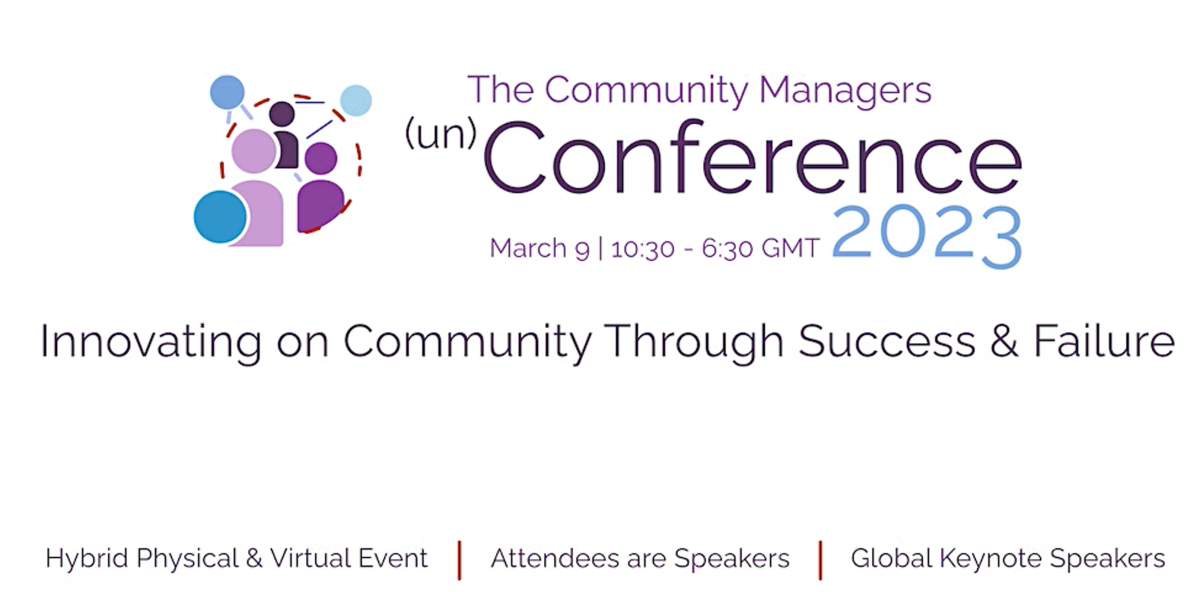This month, I attended my first community (un)conference to connect with like-minded community managers from different industries, share ideas and learn about other community groups.
Hosted by James Cattell and supporting community enthusiasts the community (un)conference lets attendees collaboratively build the agenda on the day with lots of discussions on hot topics.
Here is what I learned.

Networking done right.
Our first activity of the day was networking. We had to approach someone we hadn’t spoken with and answer, “What am I hoping to get out of today’s (un)conference?”. With 10 minutes to talk, naturally, conversations drifted to our roles, communities, and what we were passionate about, allowing us plenty of time to get to know each other.
Whenever the host raised their hand, everyone needed to copy. A simple action like this was the perfect solution for getting everyone’s attention when we were in the middle of conversations.
Having a decent time to talk helped me feel much more relaxed. Everyone I spoke with was keen to share and learn but most excited to meet in person. I felt this enthusiasm throughout the day as we continued our discussions.
Topic gathering and group discussions.
Next, we wrote our topics of interest on post-it notes. The ideas were organised into themes on a board with suggestions like how you engage your community, the implications of AI and measuring success. Facilitators transferred the post-it notes Miro to capture the online responses.

We then split into groups to have a 45-minute chat and could move to different groups when we liked. This format made interactions informal leading to in-depth conversations. The engagement group talked about the minimum viable community approach, starting small to test and learn. The importance of emotional intelligence, being vulnerable and inviting it. In another group, we talked about the community lifecycle, making the time for effective onboarding, offboarding and showing appreciation.
A Meeting Owl was on tables to capture people in the room for virtual attendees. It made things more immersive, but as the event was in one open space with groups talking simultaneously, there were issues with background noise.
Unlocking the potential of consistency.
To break up the day we had two keynotes.
The first was Valentina Ruffoni, Community Experience Lead at Disciple Media, talking about the power of consistency and creating rituals that stick. Why is this important? Valentina states that for a community to be successful, we need the following:
- Build trust: when you are more connected and open with members, they are more likely to interact.
- Build momentum: community building is a marathon. It takes time. Plan for pace.
- Have focused objectives: any community needs intentional goals to help grow and meet members’ needs.
How do you start?
- Create a community plan: create a plan and review it. Critical questions you should ask when planning are in the 7 Ps of community by CMX.
- Create rituals to build habits: dedicate time to action tasks. Building a habit takes about 21 days, and cementing that habit takes about 45-60 days.
- Feedback: you won’t know what you have achieved unless you ask. Arrange direct calls, survey, or email your members to find out.
Valentina’s talk reminded me that community managers are overwhelmed, juggling different tasks and priorities. But with clear direction, patience, and consistency, you build trust and better relationships leading to a dependable community.
Innovation
Our second talk in the afternoon was by Maryblessing Okolie, about the power of experimenting with innovation.
In her words, innovation is all about “experimentation, experimentation, experimentation”. It is about thinking and acting deeper than the typical. The goal must improve the community’s well-being by creating, testing, and scaling new approaches. To get started:
- Document results: record experiments, how they went, and why they went that way, so you know when to re-try and when to abandon the idea.
- Define the purpose of experiments: Align experiments with community goals.
To hybrid or not hybrid
Hosting a successful hybrid event is still a big challenge. The Meeting Owl was a great tool to capture people in the room but, even with a small group, hybrid events need the right venue to be successful. In an open room, having one large group discussion could have worked.
Final thoughts
Would I go again? Absolutely! In-person events are in demand and rightly so. I met some fantastic, enthusiastic people who wore their hearts on their sleeves. If you want to learn about different communities and connect with community managers, an (un)conference is a great format to help participants feel at ease and get into the details.
The event created authentic, personal connections I hadn’t experienced in a conference before. This speaks to the superb organisation of the facilitators.
I found out about this event via the Guild Community Collective so join the group to learn about everything community and future events.

